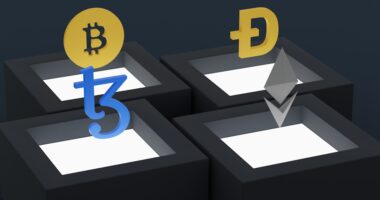NFT Art Finance, or Non-Fungible Token Art Finance, is a novel financing method that has emerged alongside the growth of NFTs in the art sector. NFTs are unique digital tokens representing ownership or authenticity of specific digital artworks or collectibles. This financing approach allows NFTs to be used as collateral for loans, enabling artists and collectors to access the value of their digital assets without selling them.
The increasing value and demand for digital art and collectibles in the NFT market have contributed to the rise of NFT Art Finance. This method provides artists and collectors with access to liquidity and capital while retaining ownership of their valuable digital assets. It has created new opportunities for artists to fund creative projects, for collectors to diversify investments, and for lenders to explore a new asset class.
As the NFT market expands, NFT Art Finance is anticipated to significantly influence the art world’s future. This innovative approach has the potential to transform the processes of buying, selling, and financing art. Consequently, NFT Art Finance has garnered attention from artists, collectors, investors, and financial institutions, establishing itself as a dynamic and promising field within the intersection of art and finance.
Key Takeaways
- NFT Art Finance is a form of investment that involves buying, selling, and trading digital artwork using non-fungible tokens (NFTs) on blockchain platforms.
- The NFT Art Finance market has experienced significant growth in recent years, with high-profile sales and increasing interest from investors and collectors.
- Investing in NFT Art Finance can be lucrative, but it requires careful research, understanding of the market, and willingness to take on the associated risks.
- It’s important to understand the risks of NFT Art Finance, including market volatility, lack of regulation, and potential for fraud and theft.
- NFT Art Finance is expected to have a significant impact on the future of the art market, creating new opportunities for artists, collectors, and investors. Additionally, it is also expected to create new job opportunities in the digital art and blockchain industries.
- NFT Art Finance is a relatively new and rapidly evolving market, and it’s important for investors and participants to stay informed about regulations and legal considerations, as they continue to develop.
The Growth of NFT Art Finance Market
The Rise of NFT-Backed Loans
The market has seen a surge in demand for NFT-backed loans, as artists and collectors seek to unlock the value of their digital assets without having to sell them. This has led to the emergence of specialized NFT Art Finance platforms and services that cater to the unique needs of the NFT market.
Institutional Investment and the Growing Ecosystem
The growth of the NFT Art Finance market has also been driven by the expanding interest from investors and financial institutions looking to capitalize on the potential of NFTs as a new asset class. As more traditional lenders and investors recognize the value of NFTs as collateral, they are increasingly exploring opportunities to participate in the NFT Art Finance market. This has led to a growing ecosystem of lenders, borrowers, and investors who are actively engaging in NFT Art Finance transactions.
A Bright Future Ahead
With the increasing mainstream adoption of NFTs and the growing acceptance of digital assets as valuable collateral, the NFT Art Finance market is poised for continued growth and expansion. As more artists and collectors embrace NFT Art Finance as a means to access liquidity and capital, and as more investors and financial institutions enter the market, the future looks bright for this innovative form of financing.
Investing in NFT Art Finance

Investing in NFT Art Finance can be an attractive opportunity for individuals and institutions looking to diversify their investment portfolios and participate in the growing NFT market. By investing in NFT Art Finance, investors can gain exposure to the potential upside of the NFT market while also benefiting from the stability and security of asset-backed lending. NFT Art Finance offers investors the opportunity to earn attractive returns by providing capital to artists and collectors who use their NFTs as collateral for loans.
These loans are typically secured by high-value NFTs, providing investors with a level of security and asset protection that is not typically found in traditional lending markets. Additionally, as the value of NFTs continues to appreciate, investors in NFT Art Finance may also benefit from potential capital appreciation on their underlying collateral. For investors looking to participate in the NFT Art Finance market, there are a variety of investment opportunities available, including direct lending platforms, investment funds focused on NFT-backed assets, and specialized financial products designed to provide exposure to NFT Art Finance.
As with any investment, it is important for investors to conduct thorough due diligence and seek professional advice to understand the risks and potential rewards associated with investing in NFT Art Finance.
Understanding the Risks of NFT Art Finance
While NFT Art Finance presents exciting opportunities for artists, collectors, and investors, it is important to understand the risks associated with this emerging form of financing. One of the primary risks of NFT Art Finance is the volatility and speculative nature of the NFT market. The value of NFTs can fluctuate significantly over short periods, which can impact the value of the collateral securing NFT-backed loans.
Additionally, as a relatively new and evolving market, NFT Art Finance may be subject to regulatory and legal uncertainties that could impact its viability and stability. The lack of established industry standards and best practices for NFT Art Finance could also pose risks for participants in the market, including potential challenges related to valuation, custody, and enforcement of collateral. Furthermore, given the digital nature of NFTs, there are inherent risks related to cybersecurity, fraud, and theft that could impact the integrity and security of NFT-backed assets.
Participants in the NFT Art Finance market must be vigilant in implementing robust security measures and protocols to mitigate these risks and protect their digital assets. It is essential for artists, collectors, investors, and lenders involved in NFT Art Finance to carefully assess and manage these risks through comprehensive risk management strategies, due diligence processes, and legal protections. By understanding and addressing these risks, participants can navigate the complexities of the NFT Art Finance market with greater confidence and resilience.
NFT Art Finance and the Future of Art Market
NFT Art Finance is poised to have a transformative impact on the future of the art market by revolutionizing how art is financed, bought, sold, and valued. As more artists and collectors embrace NFTs as a means to unlock liquidity from their digital assets, NFT Art Finance is expected to become an integral part of the art ecosystem, providing new avenues for funding creative projects and acquiring valuable art pieces. The rise of NFT Art Finance is also reshaping traditional notions of ownership and provenance in the art world.
By leveraging blockchain technology to establish verifiable ownership and authenticity of digital art through NFTs, NFT Art Finance is enhancing transparency and trust in art transactions. This has the potential to attract a broader audience of art enthusiasts and investors who are drawn to the security and transparency offered by NFTs. Furthermore, as more financial institutions and investors recognize the value of NFTs as collateral, NFT Art Finance is expected to bring greater liquidity and capital into the art market.
This influx of capital could fuel innovation, creativity, and diversity in artistic expression by providing artists with access to funding that was previously inaccessible through traditional financing channels. Overall, NFT Art Finance represents a paradigm shift in how art is valued, financed, and experienced in the digital age. By bridging the worlds of art and finance through innovative blockchain technology, NFT Art Finance is paving the way for a more inclusive, dynamic, and vibrant art market that is poised for sustained growth and evolution.
NFT Art Finance and Job Opportunities

The emergence of NFT Art Finance has created new job opportunities across various sectors, including art, finance, technology, and legal industries. As the demand for specialized expertise in NFTs and blockchain technology continues to grow, there is an increasing need for professionals who can navigate the complexities of NFT Art Finance and contribute to its development. In the art world, there is a rising demand for individuals with a deep understanding of digital art, NFTs, and blockchain technology who can advise artists and collectors on how to leverage their digital assets for financing through NFT Art Finance.
This includes roles such as NFT art consultants, digital asset managers, and art finance advisors who can help clients navigate the intricacies of the NFT market. In the finance sector, there are opportunities for professionals with expertise in alternative lending, asset-backed financing, and risk management to enter the burgeoning field of NFT Art Finance. These professionals play a critical role in structuring NFT-backed loans, assessing collateral valuation, managing credit risk, and developing financial products tailored to the unique needs of the NFT market.
Moreover, as regulatory considerations become increasingly important in the evolving landscape of NFT Art Finance, there is a growing demand for legal experts who can provide guidance on compliance, intellectual property rights, contract law, and dispute resolution related to NFT-backed assets. Legal professionals specializing in art law, technology law, and blockchain regulation are well-positioned to contribute their expertise to this emerging field. Overall, the rise of NFT Art Finance is creating diverse job opportunities for individuals with a wide range of skills and expertise who are passionate about shaping the future of art finance through innovation, creativity, and collaboration.
NFT Art Finance Regulations and Legal Considerations
As NFT Art Finance continues to gain traction in the art world, it is essential for participants in this emerging market to navigate regulatory considerations and legal implications associated with leveraging NFTs as collateral for financing. One key area of focus for regulatory considerations in NFT Art Finance is compliance with anti-money laundering (AML) and know your customer (KYC) regulations. Given the potential anonymity and cross-border nature of transactions involving NFTs, there is a need for robust AML/KYC protocols to prevent illicit activities such as money laundering or terrorist financing.
Additionally, intellectual property rights are a critical legal consideration in NFT Art Finance. Artists and collectors must ensure that they have clear ownership rights over their digital assets represented by NFTs and that they have obtained any necessary licenses or permissions for using copyrighted materials in their artwork. Failure to address these legal considerations could lead to disputes over ownership or infringement claims that may impact the validity of collateral securing NFT-backed loans.
Furthermore, as regulatory frameworks around blockchain technology continue to evolve globally, participants in NFT Art Finance must stay abreast of developments in areas such as data privacy laws, securities regulations, tax implications, and consumer protection laws that may impact their activities. By proactively addressing regulatory considerations and legal implications associated with NFT Art Finance through collaboration with legal experts and compliance professionals, participants can build trust with stakeholders, mitigate legal risks, and contribute to the long-term sustainability and legitimacy of this innovative form of financing. In conclusion, as NFT Art Finance continues to reshape the art market landscape with its innovative approach to financing digital assets through blockchain technology, it is essential for all stakeholders involved – including artists, collectors, investors, lenders, regulators – to work together towards establishing best practices that promote transparency, security, compliance with regulations while fostering creativity and innovation within this dynamic space.
If you’re interested in delving deeper into the world of NFTs, particularly from a financial perspective, you might find the article “NFT Art Finance: Understanding the Market” highly enlightening. This piece offers a comprehensive overview of the economic landscape surrounding NFTs, providing insights into how artists, investors, and collectors are navigating this burgeoning market. For further reading and to explore more about opportunities within the NFT space, you can visit NFT Jobs, a resourceful site dedicated to employment opportunities and market trends in the NFT industry.
FAQs
What is NFT art finance?
NFT art finance refers to the use of non-fungible tokens (NFTs) in the art market as a means of buying, selling, and investing in digital artwork. NFTs are unique digital assets that are stored on a blockchain and can represent ownership of a specific piece of art.
How does NFT art finance work?
In NFT art finance, artists create digital artwork and then “mint” it as an NFT, which is then sold to collectors or investors through online marketplaces. The ownership and provenance of the artwork are recorded on the blockchain, providing a secure and transparent way to buy and sell digital art.
What is the market like for NFT art finance?
The market for NFT art finance has experienced significant growth in recent years, with high-profile sales and increasing interest from collectors and investors. However, it is also a highly speculative and volatile market, with prices for NFT artwork fluctuating widely.
What are the risks and benefits of NFT art finance?
The benefits of NFT art finance include the potential for artists to reach a global audience and for collectors to own unique digital artwork. However, the market is also associated with high volatility, potential for fraud, and concerns about the environmental impact of blockchain technology.
How can someone get involved in NFT art finance?
To get involved in NFT art finance, individuals can create digital artwork, purchase NFTs from artists or online marketplaces, or invest in NFT art funds. It’s important to research the market and understand the risks before getting involved in NFT art finance.





